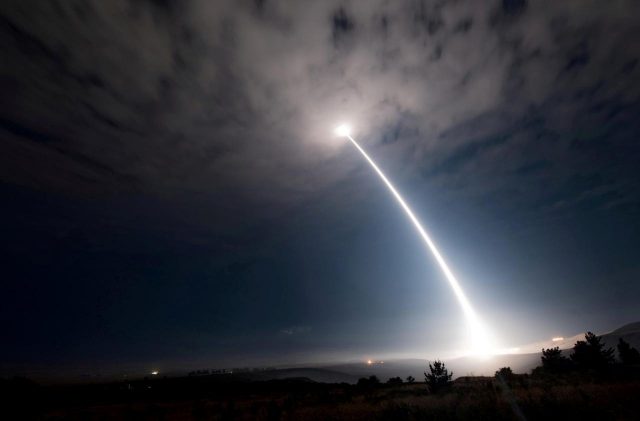
WASHINGTON — Imagine it is 3 a.m., and the president of the United States is asleep in the White House master bedroom. A military officer stationed in an office nearby retrieves an aluminum suitcase – the “football” containing the launch codes for the U.S. nuclear arsenal – and rushes to wake the commander in chief.
Early warning systems show that Russia has just launched 100 intercontinental ballistic missiles at the United States, the officer informs the president. The nuclear weapons will reach U.S. targets in 30 minutes or less.
Bruce Blair, a Princeton specialist on nuclear disarmament who once served as an ICBM launch control officer, says the president would have at most 10 minutes to decide whether to fire America’s own land-based ICBMs at Russia.
“It is a case of use or lose them,” Blair says.
A snap decision is necessary, current doctrine holds, because U.S. missile silos have well-known, fixed locations. American strategists assume Russia would try to knock the missiles out in a first strike before they could be used for retaliation.
Of all weapons in the U.S. nuclear arsenal, the ICBM is the one most likely to cause accidental nuclear war, arms-control specialists say. It is for this reason that a growing number of former defense officials, scholars of military strategy and some members of Congress have begun calling for the elimination of ICBMs.
They say that in the event of an apparent enemy attack, a president’s decision to launch must be made so fast that there would not be time to verify the threat. False warnings could arise from human error, malfunctioning early warning satellites or hacking by third parties.
Once launched, America’s current generation of ICBM missiles, the Minuteman III, cannot be recalled: They have no communication equipment because the United States fears on-board gear would be vulnerable to electronic interference by an enemy.
These critics recommend relying instead on the other two legs of the U.S. nuclear “triad”: submarine-launched ballistic missiles, and heavy bombers armed with hydrogen bombs or nuclear-warhead cruise missiles. The president would have more time to decide whether to use subs or bombers.
Bombers take longer to reach their targets than ICBMs and can be recalled if a threat turns out to be a false alarm. Nuclear missile subs can be stationed closer to their targets, and are undetectable, so their locations are unknown to U.S. adversaries. There is virtually no danger the subs could be knocked out before launching their missiles.
‘Antiquated’ arsenal
Among the advocates of dismantling the ICBM force is William Perry, defense secretary under President Bill Clinton. In a recent interview, Perry said the U.S. should get rid of its ICBMs because “responding to a false alarm is only too easy.” An erroneous decision would be apocalyptic, he said. “I don’t think any person should have to make that decision in seven or eight minutes.”
Leon Panetta, who served as defense secretary during the Barack Obama administration, defended the triad while in office. But in a recent interview he said he has reconsidered.
“There is no question that out of the three elements of the triad, the Minuteman missiles are at a stage now where they’re probably the most antiquated of the triad,” he said.
The risk of launch error is even greater in Russia, several arms control experts said. The United States has about 30 minutes from the time of warning to assess the threat and launch its ICBMs. Russia for now has less, by some estimates only 15 minutes.
That is because after the Cold War, Russia didn’t replace its early warning satellites, which by 2014 had worn out. Moscow now is only beginning to replace them. Meanwhile it relies mainly on ground-based radar, which can detect missiles only once they appear over the horizon.
In contrast, the United States has a comprehensive, fully functioning fleet of early warning satellites. These orbiters can detect a Russian missile from the moment of launch.
The doubts about the ICBM force are circulating as the world faces its most serious nuclear standoff in years: the heated war of words over Pyongyang’s growing atomic weapons program between Trump and North Korean leader Kim Jong-Un. U.S.-Russian nuclear tensions have increased as well.
The questioning of the missile fleet also comes as the United States pursues a massive, multi-year modernization of its nuclear arsenal that is making its weapons more accurate and deadly. Some strategists decry the U.S. upgrade — and similar moves by Moscow — as dangerously destabilizing.
Skeptics of the modernization program also have cited the new U.S. president’s impulsiveness as further reason for opposing the hair-trigger ICBM fleet. The enormously consequential decision to launch, said Perry, requires a president with a cool and rational personality. “I’m particularly concerned if the person lacks experience, background, knowledge and temperament” to make the decision, he said.
This month, the Senate Foreign Relations Committee held a hearing to discuss the president’s authority to launch a first-strike nuclear attack. Democratic Sen. Ed Markey of Massachusetts has called for that authority to be curbed, though such a break with decades of practice doesn’t have broad support.
“Donald Trump can launch nuclear codes just as easily as he can use his Twitter account,” said Markey. “I don’t think we should be trusting the generals to be a check on the president.”
The North Korean threat
A spokesperson for the White House National Security Council dismissed any suggestion that Trump lacks the skills to handle the arsenal. “The president is preeminently prepared to make all decisions regarding the employment of our nuclear forces,” she said.
Doubts about ICBMs predated the change of administrations in Washington.
ICBMs, detractors say, are largely useless as a deterrent against threats such as North Korea. They argue the land-based missiles can be fired only at one conceivable U.S. adversary: Russia.
That’s because, to reach an adversary such as North Korea, China or Iran from North America, the ICBMs would have to overfly Russia — thus risking an intentional or accidental nuclear response by Moscow. (A small number of U.S. ICBMs are aimed at China, in case Washington finds itself at war with both Moscow and Beijing.)
Despite the rising criticism, for now there is little chance America will retire its ICBM fleet. To supporters, eliminating that part of the triad would be like sawing one leg off a three-legged stool.
Presidents Obama and now Donald Trump have stood by them. There is little interest in Congress to consider dismantlement.
Well before Trump picked him to be defense secretary, General James Mattis raised questions about keeping the U.S. ICBM force, in part because of dangers of accidental launch. In 2015 he told the Senate Armed Services Committee: “You should ask, ‘Is it time to reduce the triad to a dyad removing the land-based missiles?’”
In his Senate confirmation hearing as defense secretary, Mattis said he now supports keeping ICBMs. They provide an extra layer of deterrence, he said, in hardened silos.
The National Security Council spokesperson said no decision had been made on keeping ICBMs. She noted that the president has ordered a review by the end of this year of U.S. nuclear policy, and no decision will be made until then.
ICBMs are part of the overall U.S. nuclear modernization program, which is expected to cost at least $1.25 trillion over 30 years. The missiles are being refurbished and upgraded to make them more accurate and lethal. And the United States is building a new class of ICBMs to be fielded around 2030.
The Air Force has confirmed that the current refurbished Minuteman IIIs have improved guidance systems and a bigger third-stage engine, which make them more precise and able to carry bigger payloads.
Brushes with Armageddon
The U.S. nuclear missile force dates back to the 1950s. Lacking expertise in making rockets, the United States after World War II scoured Germany for the scientists who had built the V2 rockets Germany fired on England. Under a secret plan, Washington spirited scientists such as Wernher von Braun, later considered the father of American rocketry, out of Germany, away from possible war crimes prosecution, in exchange for helping the United States.
By 1947 the Cold War was on. The former Nazi rocket designers would help America build super-fast, long-range missiles that could rain nuclear warheads on the Soviet population.
The program began slowly. That changed on October 4, 1957. The Soviet Union launched Sputnik, a small satellite, into Earth orbit, beating the United States into space. For the Pentagon, the most significant fact was that Sputnik had been launched by an ICBM capable of reaching the U.S. homeland. The United States put its missile program into overdrive, launching its own ICBM in November 1959.
The ICBMs’ advantage over bombers was that they could reach their targets in 30 minutes. Even bombers taking off from European bases could take hours to reach their ground zeroes.
By 1966, once an order was given to missile crews, pre-launch time was minimized to five minutes. This resulted from a change in fuel. Before, liquid fuel powered ICBMs. In a lengthy process, it had to be loaded immediately before launch. The invention of solid fuel solved the problem. It was installed when the missile was built, and remained viable for decades.
One reason arms specialists worry about the ICBM force is that the United States and Russia have come close to committing potentially catastrophic errors multiple times.
In 1985, for example, a full nuclear alert went out when a U.S. Strategic Command computer showed that the Soviet Union had launched 200 ICBMs at the United States. Fortunately, Perry recounts in his book, “My Journey at the Nuclear Brink,” the officer in charge realized there was a fault in the computer and that no missiles had been launched. The problem was traced to a faulty circuit board, but not before the same mistake happened two weeks later.
In 1995, then-Russian president Boris Yeltsin had his finger on the button, because the Russians had detected a missile launched from Norway, which they assumed to be American. Russian officials determined just in time that it was not a nuclear missile.
They later learned it was a harmless scientific-research rocket. Norway had warned Russia well in advance of the launch — but the information was never passed on to radar technicians.









